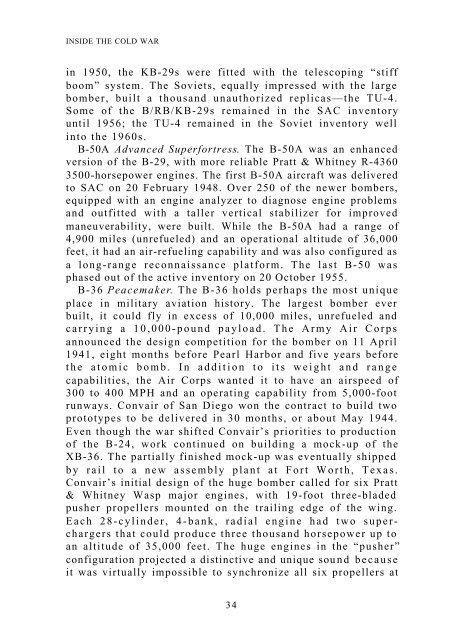Create successful ePaper yourself
Turn your PDF publications into a flip-book with our unique Google optimized e-Paper software.
INSIDE THE COLD WAR<br />
in 1950, <strong>the</strong> KB-29s were fitted with <strong>the</strong> telescoping “stiff<br />
boom” system. The Soviets, equally impressed with <strong>the</strong> large<br />
bomber, built a thousand unauthorized replicas—<strong>the</strong> TU-4.<br />
Some of <strong>the</strong> B/RB/KB-29s remained in <strong>the</strong> SAC inventory<br />
until 1956; <strong>the</strong> TU-4 remained in <strong>the</strong> Soviet inventory well<br />
into <strong>the</strong> 1960s.<br />
B-50A Advanced Superfortress. The B-50A was an enhanced<br />
version of <strong>the</strong> B-29, with more reliable Pratt & Whitney R-4360<br />
3500-horsepower engines. The first B-50A aircraft was delivered<br />
to SAC on 20 February 1948. Over 250 of <strong>the</strong> newer bombers,<br />
equipped with an engine analyzer to diagnose engine problems<br />
and outfitted with a taller vertical stabilizer for improved<br />
maneuverability, were built. While <strong>the</strong> B-50A had a range of<br />
4,900 miles (unrefueled) and an operational altitude of 36,000<br />
feet, it had an air-refueling capability and was also configured as<br />
a long-range reconnaissance platform. The last B-50 was<br />
phased out of <strong>the</strong> active inventory on 20 October 1955.<br />
B-36 Peacemaker. The B-36 holds perhaps <strong>the</strong> most unique<br />
place in military aviation history. The largest bomber ever<br />
built, it could fly in excess of 10,000 miles, unrefueled and<br />
carrying a 10,000-pound payload. The Army Air Corps<br />
announced <strong>the</strong> design competition for <strong>the</strong> bomber on 11 April<br />
1941, eight months before Pearl Harbor and five years before<br />
<strong>the</strong> atomic bomb. In addition to its weight and range<br />
capabilities, <strong>the</strong> Air Corps wanted it to have an airspeed of<br />
300 to 400 MPH and an operating capability from 5,000-foot<br />
runways. Convair of San Diego won <strong>the</strong> contract to build two<br />
prototypes to be delivered in 30 months, or about May 1944.<br />
Even though <strong>the</strong> war shifted Convair’s priorities to production<br />
of <strong>the</strong> B-24, work continued on building a mock-up of <strong>the</strong><br />
XB-36. The partially finished mock-up was eventually shipped<br />
by rail to a new assembly plant at Fort Worth, Texas.<br />
Convair’s initial design of <strong>the</strong> huge bomber called for six Pratt<br />
& Whitney Wasp major engines, with 19-foot three-bladed<br />
pusher propellers mounted on <strong>the</strong> trailing edge of <strong>the</strong> wing.<br />
Each 28-cylinder, 4-bank, radial engine had two superchargers<br />
that could produce three thousand horsepower up to<br />
an altitude of 35,000 feet. The huge engines in <strong>the</strong> “pusher”<br />
configuration projected a distinctive and unique sound because<br />
it was virtually impossible to synchronize all six propellers at<br />
34
















